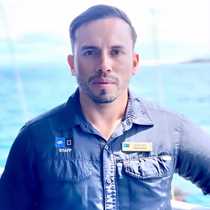Santa Cruz Island
Early in the morning we had a post-breakfast outing, with a dry landing on the pier of Puerto Ayora (the largest town in the Galápagos Islands). After a five-minute bus ride, we arrived at the entrance to the Galápagos National Park and walked past the Charles Darwin Research Station, an amazing place where we got to learn about the major projects that are being applied to increase the rate of survival of endemic species from the islands like the land iguanas and other species to the rearing center for the giant tortoises. Some of those efforts involve the eradication of introduced species from the fragile environment of the archipelago.
Here we met some of the most important characters among the endemic species of the islands such as Lonesome George (the last tortoise of its kind), Super Diego (male tortoise belonging to the race of tortoises from Española island; he helped in the recovery of the population by mating with the few females found), and also some of the hatchlings of the giant tortoises which will have a very important role in the ecosystem as they are repatriated little by little back to their home islands. Some cactus finches and ground finches were also spotted.
After walking back to town, we had a 45-minute bus ride to the highlands of Santa Cruz. As we drove higher, we could see the changing vegetation zones; from very dry and arid up to very green and humid; very different from what we had gotten used to. Some of us did walk a couple of miles, as exercise, to get to the restaurant for lunch.
We had a delicious lunch and soon headed even further into the highlands to explore "Los Gemelos," also known as pit craters (created by the collapse of the magma chamber). The area is surrounded by the "milky forest" (made up of the endemic giant Scalesia trees) where we spotted several individuals of the woodpecker finch; this forest is one of the finch's most important habitats.
We also visited a private farm where we had a very interesting walk in the grasslands where we were able to find many male giant tortoises (most females have already started to migrate to the arid zone to lay eggs); they were grazing or even resting in the rain water ponds where some common gallinules and pintail ducks were also enjoying the water.
One of the main highlights for some of us was spotting the vermilion flycatcher, a very rare bird nowadays that has a bright red-colored body with a black mask covering its eyes. This was something that doesn’t happen every day since the population of these birds is being diminished by other introduced species such as the cattle egret and smooth-billed ani.
After a very exciting day, full of activity and knowledge, we left the green highlands and headed back into town to the Zodiacs and back to the National Geographic Endeavour.



